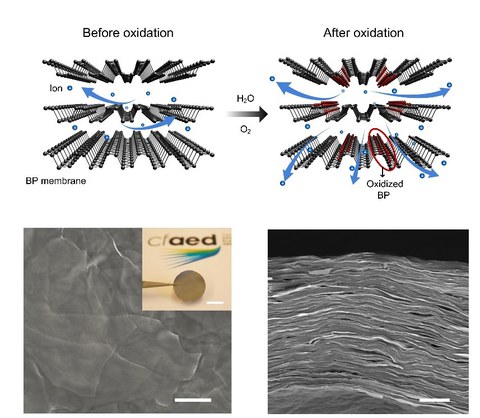17.06.2020
Electrochemically exfoliated black phosphorus for osmotic power generation
Engineering two-dimensional (2D) membranes has been an effective approach to boost the harvesting of the “blue” osmotic energy between river water and sea water. Black phosphorus (BP), an emerging layered material, has recently been explored for a wide range of ambient applications. However, little attention has been paid to the extraction of the worldwide osmotic energy, despite its large potential as an energy conversion membrane. The researchers from TUD report an experimental investigation of BP membrane in osmotic energy conversion. Through controllable oxidation in water, power output of the BP membrane can be largely enhanced, which can be attributed to the generated charged phosphorus compounds. Depending on the valence of oxidized BP that is associated with oxygen concentration, the power density can be precisely controlled and substantially promoted by ∼220%. Moreover, through constructing a heterostructure with graphene oxide, ion selectivity of the BP membrane increases by ∼80%, contributing to enhanced charge separation efficiency. When mixing natural sea water and river water, the power density can achieve about 4.7 W m-2. This work highlights the large potential of BP in surface-charge-governed aqueous nanofluidic energy devices.
This work was supported by the Alexander von Humboldt Foundation, the European Union’s Horizon 2020 research and innovation program under Grant 881603, the European Science Foundation, and the Coordination Networks: Building Blocks for Functional Systems (SPP1928).
Reference:
Zhen Zhang, Panpan Zhang, Sheng Yang, Tao Zhang, Markus Löffler, Huanhuan
Shi, Martin R. Lohe and Xinliang Feng*, Oxidation promoted osmotic energy conversion in black phosphorus membranes, PNAS, 2020, DOI: https://doi.org/10.1073/pnas.2003898117.

